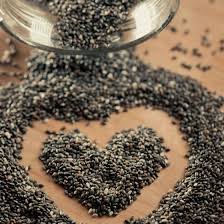Chia Seeds: Fad or Fabulous?
 Okay, can something be a bit of a fad and be fabulous at the same time? I think so, and chia seeds are just such an item. Chia has been grown and used for centuries, and its seeds have been available for years at specialty health food stores, but its recognition as a healthy food is only starting to become mainstream. An increasing number of food producers, like Dole and Nature's Path, are making products that contain chia seeds. It's also becoming more common to find them in grocery store chains like Fred Meyer and Albertson's, rather than only at natural food stores like Granola's and Whole Foods. This sudden surge in the popularity and availability of chia seeds is why they fit loosely into the "fad" category, but like I said, they are fabulous regardless of whether or not they truly become mainstream.
Okay, can something be a bit of a fad and be fabulous at the same time? I think so, and chia seeds are just such an item. Chia has been grown and used for centuries, and its seeds have been available for years at specialty health food stores, but its recognition as a healthy food is only starting to become mainstream. An increasing number of food producers, like Dole and Nature's Path, are making products that contain chia seeds. It's also becoming more common to find them in grocery store chains like Fred Meyer and Albertson's, rather than only at natural food stores like Granola's and Whole Foods. This sudden surge in the popularity and availability of chia seeds is why they fit loosely into the "fad" category, but like I said, they are fabulous regardless of whether or not they truly become mainstream.
Well if you're like a lot of people, you're reading this article and wondering, "Chia seeds? What are chia seeds anyway?" The chia plant is a flowering plant in the mint family that is native to Mexico and Guatemala, and also grown in other parts of Central and South America. The seeds of the chia plant are small ovals, only about a millimeter in diameter, and are generally black, gray, brown or white. These seeds are power packed with nutrients, including fiber, calcium, omega-3 and omega-6, and therefore make a great addition to any snack or meal. The omega fatty acids are considered essential fats that are necessary for our health. Since our bodies don't produce these fats we must get them from the things we eat, which is why eating foods that contain these fats is critical to good nutrition.
Let's take a look at some of the nutrients available in chia seeds. Each one ounce serving (about two tablespoons) has 137 calories and provides the following benefits:
- Digestive health - with 11 grams of fiber that's about one third of the recommended daily intake (RDI).
- Strong teeth & bones - each serving provides 18% of the RDI for calcium, 30% of the RDI for manganese, & 27% of the RDI for phosphorus.
- Muscle building & tissue repair - each serving provides 4 grams of protein, about 10% of the RDI.
- Heart & brain health - each serving is packed with almost 5 grams of Omega 3 fatty acids and 1.6 grams of Omega 6 fatty acids. These healthy fats can help decrease blood pressure and triglycerides, improve cholesterol, and boost memory and overall mental performance.
Considering the numerous benefits of chia seeds, you may be wondering if adding them to your own diet is a good idea. What I often recommend is using a combination of nuts and seeds rather than focusing on only one, so let's look at how chia seeds compare with other popular seeds. Seeds with similar health benefits are flax, hemp and sunflower seeds. Flax seeds are high in thiamin, magnesium and manganese, have almost 8 grams of fiber, and over 6 grams of omega-3 per 150 calorie serving. They have a bit more omega-3 than chia seeds, so they are a great choice for increasing healthy fat in the diet. There are a couple issues people have with these seeds though: they need to be refrigerated and they must be ground before eating. An ounce of hemp seeds has 162 calories, is high in magnesium and zinc, and provides a whopping 10 grams of protein. Since a serving of hemp seeds has over twice the protein of chia seeds, hemp seeds are a better choice for boosting protein intake. Sunflower seeds are rich in the antioxidant Vitamin E, as well as other vitamins and minerals, contain 6 grams of protein, and have 164 calories per one ounce serving. Clearly flax, hemp and sunflower seeds all provide terrific nutrients as well, so what makes chia seeds a good choice?
Here are a few of the biggest reasons for choosing chia over other seeds:
- Chia seeds are high in fiber and calcium. Anyone looking to add natural fiber and/or calcium to their diet can easily do this by incorporating these little seeds into their snacks and meals. Chia seeds far surpass other seeds in both of these nutrients.
- Chia seeds do not have to be ground or milled. Unlike flax seeds which need to be ground in order to get the nutrients from them, the healthful nutrients in chia seeds are gained whether they are eaten whole or milled. This is because the outer husk of the chia seed is easily digested, whereas the flax seed husk is much tougher.
- Chia seeds are tasteless. So now you may be thinking, "Is being tasteless a good thing?", but consider what this means in terms of cooking. These seeds can be added to any type of food without changing the flavor of the food. You can add them to baked goods like breads and cookies, to stir-fries, salads, cereals, smoothies, and just about anything else you can think of, without making the food taste different. One thing to note is that they do absorb a lot of water, and develop a gel-like coating when soaked in liquid, so they may affect the texture of foods.
You can buy whole and ground chia seeds at almost any large grocery store, natural food market, or supplement store. As the awareness of the many health benefits of chia seeds grows, more and more products are being made with them. Here are a few that you can find (in the nutrition aisle or organic food area usually) at grocery stores like Safeway, Central Market, QFC & Fred Meyer:
- Nature's Path: Coconut Chia Granola Cereal, and Honey Almond Granola with Chia
- KIND: Maple Quinoa Clusters with Chia Seeds
- Mamma Chia: Chia-infused fruit juices and squeezes
- Barlean's (a local Washington company): Flax-Chia-Coconut blend, and Organic chia seeds
Although chia seeds may be a bit of a fad, they are definitely very nutritious little seeds. Since it is important to eat a balanced, healthy diet from a variety of foods, I encourage you to try chia seeds for yourself and see what you think!

